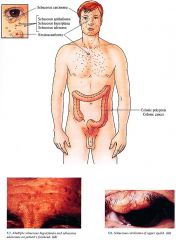![]()
![]()
![]()
Use LEFT and RIGHT arrow keys to navigate between flashcards;
Use UP and DOWN arrow keys to flip the card;
H to show hint;
A reads text to speech;
11 Cards in this Set
- Front
- Back
|
Clinical Muir-Torre Syndrome
|

|
|
|
Inheritance
|
Autosomal dominant; MSH1 and MSH2 genes on 3p2l and 2p22 21, respectively
|
|
|
Prenatal
|
DNA analysis
|
|
|
Incidence
|
At least 65 cases reported; M=F
|
|
|
Age of Presentation
|
Fifth to sixth decade of life (internal malignancies usually precede cutaneous lesions)
|
|
|
Pathogenesis
|
Mutations in MSH2 (most common) and MSH 1, DNA mismatch repair genes, produces phenotype;
syndrome is linked to the Lynch II cancer family syndrome |
|
|
Clinical
|
Skin
Multiple sebaceous tumors: adenomas (most common), carcinomas, hyperplasias, epitheliomas, basal cell carcinoma with sebaceous differentiation Keratoacanthomas Neoplasms Adenocarcinoma of the colon (most common), other gastrointestinal tract, genitourinary tract, lung, breast, and hematologic malignancies described |
|
|
DDx
|
Cowden syndrome
Gardner syndrome |
|
|
Lab
|
Skin biopsy
Endoscopy/gastrointestinal x ray |
|
|
Management
|
Close follow up by internist screening for malignancy Referral to dermatologist Referral to gastroenterologist
|
|
|
Prognosis
|
Malignancies usually low grade with good prognosis; may have normal life span with close surveillance and early detection of malignancy
|

